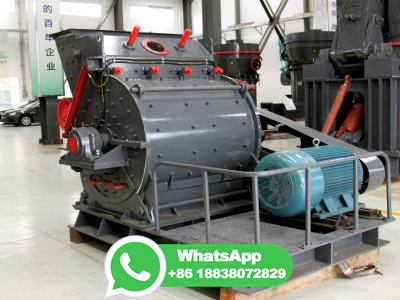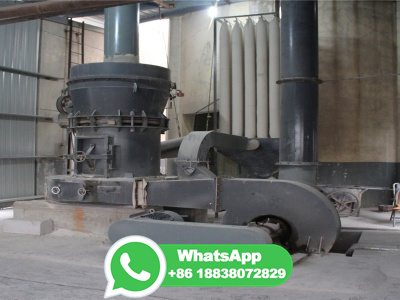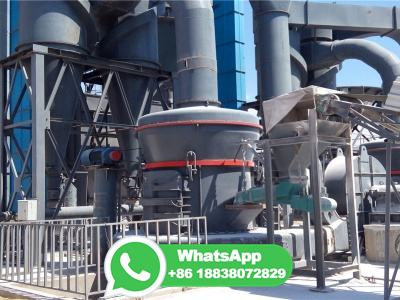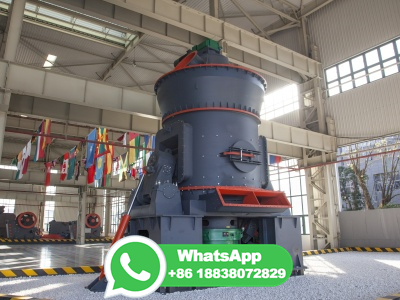
Alumina is produced from bauxite, an ore that is mined from topsoil in various tropical and subtropical regions. The Bayer process, discovered in 1887, is the primary process by which alumina is extracted from bauxite. Bauxite is the general name given to the hydrated oxides of aluminium. It contains varying amounts of combined water and ...
WhatsApp: +86 18037808511![[PDF] Methods for Alkaline Recovery of Aluminum from Bauxite Residue ...](/vfunlqm/293.jpg)
Different ways for alkaline recovery of aluminum from bauxite residue are considered from the literature and examined in experiments. The advantages and disadvantages of a hightemperature digestion via Bayer process and sodalime sintering process are elaborated and compared. As a hybrid process, bauxite residue undergoes a reductive smelting process with lime addition in an electric arc ...
WhatsApp: +86 18037808511
The Bayer process for alumina production generates more than 160 million tons of bauxite residue annually. The current global stockpiles of bauxite residue have reached more than 4 billion tons ...
WhatsApp: +86 18037808511
The Bayer process holds an exclusive status for alumina extraction, but a massive amount of caustic "red mud" waste is generated. In this work, three oxalate reagents: potassium hydrogen oxalate (KHC 2 O 4), potassium tetraoxalate (KHC 2 O 4 ·H 2 C 2 O 4), and oxalic acid (H 2 C 2 O 4) were investigated for the Al and Fe extraction process from NIST SRM 600 AustralianDarling range ...
WhatsApp: +86 18037808511
Life cycle of an aluminum can. The extraction process occurs in three steps: bauxite extraction, alumina refining, and primary smelting. The other steps apply to both extracted and recycled aluminum. ... Aluminum extraction requires temperatures of 1,000 o C and a lot of energy. Additional material—such as cryolite and sodium hydroxide—need ...
WhatsApp: +86 18037808511
Fig. : Production steps for aluminum. Bauxite mining Aluminum comprises approximately 8% of the earth's crust, making it second only to silicon (%). Iron is third at about 5%. Metallic aluminum is not found in nature; it occurs in the form of hydrated oxides or silicates (clays).
WhatsApp: +86 18037808511
The rapid development of the global alumina and aluminum industry is straight coupled with the demands and the needs of these materials. Nowadays, the only wellknown accessible resources to produce alumina and aluminum are bauxite ores. But bauxite ores are limited, and the remaining exploitable reserves do not have high contents in alumina. In countries where there is little or no bauxite ...
WhatsApp: +86 18037808511
A closedloop valorization process, combining carbothermic smelting and acid baking water leaching was developed to recover scandium, aluminum, and iron from bauxite residue, a major side product of aluminum production. This process employs carbothermic smelting to recover 99% of the iron in the starting residue as crude metallic iron, which can be separated from slag that contains ...
WhatsApp: +86 18037808511
Electrometallurgy is a common extraction process for the more reactive metals,, for aluminum and metals above it in the electrochemical series. It is one method of extracting copper and in the purification of copper. During electrolysis, electrons are being added directly to the metal ions at the cathode (the negative electrode).
WhatsApp: +86 18037808511
Extracting aluminium from bauxite using electrolysis Aluminium occurs naturally as aluminium oxide in the rock bauxite. It is mined from the ground in huge open cast mines in Australia, Jamaica, Guinea, Brazil and Russia. The aluminium oxide is purified into alumina (a pure white powder form of aluminium oxide) so it is easier to transport to
WhatsApp: +86 18037808511
Aluminium ore close ore A rock containing enough quantities of a mineral for extraction to be possible. is called bauxite (Al 2 O 3).The bauxite is purified close purified A substance that has ...
WhatsApp: +86 18037808511
HallHeroult process is still both capital and energy intensive. Assuming that electricity is produced from fossil fuel at 32% conversion efficiency, about 284 OJ (fossil fuel equivalent) are used to produce 1 tonne aluminum from bauxite in the mining, alumina extraction, and electrolytic reduction stages. Of this,
WhatsApp: +86 18037808511
The Bayer process is used for refining bauxite to smelting grade alumina, the precursor to aluminum. Typically, depending upon the quality of the ore, between and tonnes of bauxite is required to produce 1 ton of alumina. The Bayer process involves the digestion of crushed bauxite in the concentrated sodium hydroxide (caustic) solution at
WhatsApp: +86 18037808511
Aluminium extraction begins with bauxite ore, a type of rock rich in aluminium oxide. This oxide must then be processed into a purer form before it can be used to make aluminium. To do this, the ore must first be heated until it reaches temperatures up to 1,000 degrees Celsius (1,800°F). This high temperature causes the aluminium oxide ...
WhatsApp: +86 18037808511
Aluminum production from bauxite is achieved with the Bayer process, which is a hydrometallurgical method. However, in the Bayer process, in time, it is possible to encounter problems such as the formation of excessive amounts of red mud in aluminum production, its environmental risks, its requirement of large storage sites, the excessive production of reactants by ores with low silica modulus ...
WhatsApp: +86 18037808511
In 2020, the reported quantity of bauxite consumed was estimated to be 4 million tons, slightly more than that reported in 2019, with an estimated value of about 110 million. About 79% of the bauxite was refined by the Bayer process for alumina or aluminum hydroxide, and the remainder went to products such as
WhatsApp: +86 18037808511
In pyrometallurgical process, Al and Sibearing minerals in iron and aluminum ores are easily transformed into sodium aluminosilicates in the presence of Na2O constituents, which alters the leaching behaviors of Al2O3 and SiO2. It was confirmed that sodium aluminosilicates with different phase compositions synthesized at various roasting conditions were effectively digested in the alkaline ...
WhatsApp: +86 18037808511
The bauxite is purified to produce aluminium oxide, a white powder from which aluminium can be extracted. The extraction is done by electrolysis. The ions in the aluminium oxide must be free to ...
WhatsApp: +86 18037808511
The production of aluminum from bauxite is a twostep process: refining bauxite to obtain alumina and smelting alumina to produce aluminum. Bauxite contains a number of impurities, including iron oxide, silica, and titania. If these impurities are not removed during refining, they will alloy with and contaminate the metal during the smelting ...
WhatsApp: +86 18037808511
Bauxite is the name given to aluminium ore. To produce aluminium oxide, bauxite is purified. This results in a white powder from which aluminium can be extracted. Aluminium oxide has a very high melting point of over 2000° C, making melting it an expensive process. Aluminium oxide is insoluble in water, but it dissolves in molten cryolite.
WhatsApp: +86 18037808511
During the digestion process of the Bayer method, lithium and gallium in bauxite will enter into the sodium aluminate solution (Tang et al. 2020; Xu et al. 2018), which will return to the digestion process for recycling after the precipitation of aluminum hydroxide from the decomposition of crystal to a large amount of red mud discharge, most of the lithium and gallium in the ...
WhatsApp: +86 18037808511
Almost 800 million tonnes of aluminium are extracted each year from bauxite, and so the extraction of aluminium is of immense commercial importance. The extraction of aluminium takes place in two principal stages; the purification of Al. 2. O. 3. ... The extraction process produces polluting gases like sulphur dioxide and carbon
WhatsApp: +86 18037808511
Bauxite is generally extracted by open cast mining, being almost always found near the surface, with processes that vary slightly depending on the location. Before mining can commence the land needs to be cleared of timber and vegetation. Alongside this process may be the collection of seeds and/or saplings, for inclusion in a seedbank, which ...
WhatsApp: +86 18037808511
Alumina Extraction Problem. In the standard Bayer Process for refining bauxite to produce alumina, the dissolution of the alumina in the ore to form sodium aluminate is accomplished in autoclaves under high pressures varying from 70 to 200 pounds per square inch. However, some lateritic bauxite ores are readily soluble in caustic, making it ...
WhatsApp: +86 18037808511
Follow. New York, Dec. 04, 2023 (GLOBE NEWSWIRE) The global aluminum market is projected to expand at a CAGR of %, increasing from a value of US B n in 2023 to US Bn by the end of ...
WhatsApp: +86 18037808511
Bauxite mine tailings can be used as the reserve resources of aluminium and lithium. In this study, a less energy consumption treatment method for extracting aluminium and lithium from bauxite mine tailings has been proposed, which used mixed acid to leach aluminium and lithium from tailings directly, avoided roasting for reducing energy consumption, and obtained effective minerals ...
WhatsApp: +86 18037808511
the aluminium industry. Guyana's endowment with relatively large deposits of bauxite, rich in aluminium oxide and mineralogically compatible with the alumina technology used by the North American alumina industry, led to the country becoming the major supplier of bauxite to North America during the Second World War.
WhatsApp: +86 18037808511
In this process, aluminium compounds of bauxite ore are dissolved in hot sodium oxide solution at 150200 °C. Bauxite is a naturally occurring sedimentary rock which is the principal source for industrially produced aluminium. ... Their genius extraction process changed Aluminium from a luxury material to a commodity metal, with an annual ...
WhatsApp: +86 18037808511
As discussed by Valeev et al. [38], the solubility of aluminum as hydroxide (AlOOH and Al(OH) 3 ) form in bauxite ore is significantly different compared to the oxide (Al 2 O 3 ) in calcined ...
WhatsApp: +86 18037808511
Manufacture of aluminum Primary manufacture involves four processes: a) extraction of the ore, bauxite b) purification of bauxite to pure aluminum oxide (alumina) c) synthesis of cryolite, Na3AIF6 and aluminum fluoride, to be used in the electrolytic reduction process d) electrolytic reduction of aluminum oxide to aluminum Extraction of the ...
WhatsApp: +86 18037808511
C. The importance of the aluminium sector to Brazil 11 II. ENVIRONMENTAL EFFECTS OF PRODUCING BAUXITE, ALUMINA AND ALUMINIUM 13 A. Introduction 13 B. Bauxite mining 14 1. MRN 14 Revegetation 14 Bauxite Tailings Disposal 14 Rehabilitation of Lake Batata 15 Control of solid particles emissions 17 MRN's environmental policy 17 2.
WhatsApp: +86 18037808511
A short video clip illustrating the process of aluminium extraction that can be viewed online by students or downloaded for showing in class. ... Aluminium extraction questions PDF, Size ; Aluminium extraction answers PDF, Size kb ... Aluminium from bauxite: bauxite → pure aluminium electrolysis to aluminium. England. GCSE.
WhatsApp: +86 18037808511
Keywords Bauxite residue · Red mud · Aluminum extraction · Aluminum recovery · Sodium carbonate sintering · Bayer process Introduction Although aluminum is one of the most abundant metals in earth's crust, its first isolation was succeeded in 1825 by Christian Ørsted who firstly gained anhydrous aluminum chloride [1].
WhatsApp: +86 18037808511
Alumina is the common name given to aluminum oxide (Al2O3). Alumina is produced from bauxite, an ore that is mined from topsoil in various tropical and subtropical regions. The Bayer process, discovered in 1887, is the primary process by which alumina is extracted from bauxite.
WhatsApp: +86 18037808511
evaluated to determine its constituents and feasibility of extracting aluminum by Bayer Process. Al, Fe, Ti, Ca, Na, K, Mg, Cl, and Si have been estimated in the samples .The highest alumina (Al 2 ...
WhatsApp: +86 18037808511